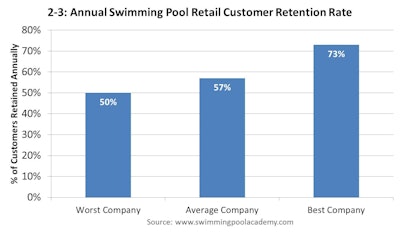According to a credible survey by Bain & Company, U.S. corporations on the average lose half their customers every five years. This fact shocks most people. What’s more, it surprises the corporate CEOs themselves because most do not measure customer retention, make little effort to prevent defections, and fail to use defections as a guide to improvement.
There is little doubt that swimming pool retailers believe retaining customers long term is extremely important. But they share a characteristic with these corporate CEOs. Very few, if any, understand exactly how they are doing at this business-critical activity. The good news is that never before have technological tools been more available or affordable to gain insight into this critical area.
Creating a benchmark
Understanding how your company’s annual customer retention rate compares to the overall pool industry can be used as a benchmark to improve your performance. So we decided to create this reference point. First we defined average annual retention rate as the percent of customers that purchased last year and are still buying this year. Then, using our entire point-of-sale database, we calculated the average annual retention rate for our sample of 88,000 retail consumers. This new industry standard is shown in chart 2-3 for the “average company” in the sample.

Who aspires to be average?
Average really isn’t a suitable goal. The expression “we perform consistently with the average company” may justify mediocre performance but it does not serve to improve results. So we also identified the best and worst retention rates within our sample. As can be seen in chart 2-4, the best performer clearly outshines the average with a seemingly impressive 73 percent annual retention rate. Now that is a good starting point if you want to improve your performance, but that too can be deceiving.
When does 73=53?
Even for the best performer, retention rates can also mislead. If this company experiences an annual retention rate of 73 percent each year for its original group of customers, it will end up with only 73 percent of those customers after the first year, and just 53 percent of those customers after the second year (73 percent x 73 percent = 53 percent). Yikes, that means they will lose nearly half of their customers over a two-year period.
This is a huge potential profit drain which cannot be counteracted simply by recruiting new customers as replacements. It is imperative to make sure it is not overlooked. Most companies in our industry are not aware of the loss associated with customer defection and the substantial profit recovery potential related to winning some of these lost customers back. Look for more on this subject and opportunities to improve in future posts.
Your turn
Does your company know its annual customer retention rate? If so, would you share it with our readers? How are you using that knowledge to improve your business? What kind of help could you use in improving your customer retention?
See the previous post in this series: The Reality of Customer Loyalty











































